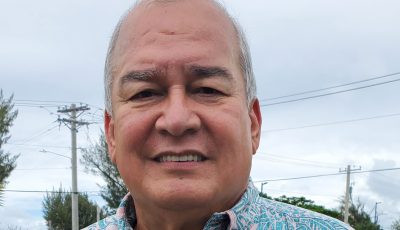PERSON OF THE YEAR
NMI’s first responders

A lineman fixes the connection along Beach Road as part of the efforts to bring power back to the entire island. (Jon Perez)
There are many professions that fall under the term “first responders”: EMTs, police officers, soldiers, firefighters, utility linemen, nurses, physicians, etc. But, however else you call them, first responders are known for simply one thing—they rush toward the crisis point, sometimes even at the risk of their own lives, even as others run away.
In the case of the CNMI, when Super Typhoon Yutu’s ferocious winds leveled whole swaths of Saipan and Tinian, the howling winds and devastation laid bare in the early morning hours of Oct. 25 also brought to the fore the indomitable spirit of the CNMI’s first responders, uncovering souls of steel that allowed them to lay aside their own wounds to rush to the rescue of thousands of others who’ve lost homes and properties to the typhoon. That capacity to rise beyond their own needs to help others make the CNMI’s first responders the Saipan Tribune’s Person of the Year.
That includes not just the men and women at the Commonwealth Utilities Corp., Department of Public Safety, Department of Fire and Medical Emergency Services, and Commonwealth Health Center, but also the brave men and women of the U.S. Armed Forces, U.S. Army Reserve, the CNMI Homeland Security and Emergency Management, and the Saipan, Tinian, and Rota mayors’ offices.
Super Typhoon Yutu barreled through Saipan and Tinian on Oct. 24 just as 2018 was nearing its end, with winds of 180 mph and gusts of up to 220 mph that went on for over six hours.
The widespread devastation and damage to the islands and thousands of displaced lives placed the burden of crisis management squarely on the shoulders of first responders. Thankfully for the CNMI, it has its share of superheroes. The courage, bravery, and perseverance of the men and women of CUC, DPS, DFEMS, CHC, and HSEM is becoming the bedrock upon which the CNMI is rebuilding. Just days after Yutu, the Commonwealth Health Center was already on CUC power. For comparison, it took several months before power was restored after Typhoon Soudelor in 2015.
CUC executive director Gary Camacho said that, hours before Yutu hit, he was communicating with Guam Power Authority on how CUC can help.
“When Yutu was tracking south, we were coordinating with Guam about how we can help. But when Yutu started going north, our roles were switched,” he said.
According to Camacho, on the morning after of the storm, CUC immediately kicked off its plan to repair the islands and restore power and water.
With over 60 percent of the island now back on power three months after the typhoon, Camacho attributed it to “big unified program” by 400 CUC employees .
“It’s a concerted effort…We’ve got personnel support groups all the way around to assist the people on the field,” he said.
Camacho assured that that CUC is working continuously and diligently to get Saipan and Tinian back on its feet again. “CUC is blessed with such hardworking people and with strong relationships with other utilities,” he said. “We are also…working…to make our system stronger for the inevitable storms in the future. Our commitment is we will continue to develop and grow from here.”
That commitment is reflected at DPS. DPS Commissioner Robert Guerrero said their work never ends. He said the department is not like any other office. Police officers don’t get sent home before a typhoon comes to prepare and be with their families; there is no reason for the men and women of DPS to just clean their desks and say “see you tomorrow.”
In fact, DPS men and women are faced with difficult decisions during a crisis “because we put lives in danger.”
“It’s a hard decision where at 3am we received a call about a family stranded in As Teo. So many thoughts were running in my head,” he said. “We did rescues…in the morning as we assisted people who were trapped in their houses. We were getting calls but we couldn’t mobilize many because it was still dangerous to drive in the streets… but the minute we were able to go, we didn’t stop anymore. …We rescued people and brought them to the shelter,” he added.
Guerrero said that Super Typhoon Yutu recovery efforts were made easy by officers and staff working together. “The people I thought didn’t get along, all worked together. Everything fell into place. …It was very touching…because I saw them coming together as one and this is one of the hardest agencies to manage because of the ego issues. Every person, including me, sustained damage in our homes, but the people who weren’t speaking to each other before Yutu are actually working hand in hand now.”
According to Guerrero, every officer and staff in DPS are committed to execute what they’re sworn to do and that is to put the community first. “The officers out there doing their duties, they also incurred damage, like houses being blown away,” he said.” …These guys didn’t get to line up first for the water, MREs, DNAP. In fact, they were the last group to go on the last day and I give credit to them, most especially the families, because of their strong support as this job is hard to do without the support of the families.”
Thankfully, DFEMS has a standard operating procedure for typhoons. “We learned a lot from Typhoon Soudelor and thus we have our S.O.P. in place,” DFMES spokesman Derek Gersonde said. That includes taking the lead in installing temporary homes under the TETRIS program.
“Seeing how resilient the people of the CNMI are, how we help one another and knowing that we are out there to make a difference—that is our true motivation…,” he said.
At the hospital, Commonwealth Healthcare Corp. CEO Esther Muña knew beforehand that, based on the weather advisories, Yutu was going to be a strong one.
“When we prepare for a typhoon, we are getting the only hospital in the CNMI to be ready, together with Rota and Tinian to respond to any disaster related sickness and injuries,” she said.
That meant preparing the hospital staff and patients and ensuring enough supply of water and fuel.
This was echoed by Public Health & Hospital Emergency Preparedness Program director Warren E. Villagomez. “We dive into a checklist and we do not only think of Saipan but also of Rota and Tinian.
Opening mobile clinics is considered one of the best decisions they made. “We know people who are injured tend to first take care of their properties and this means that they would delay care for their own health. …We cannot help but be responsible for them and we also don’t want people to wait to receive health care,” Muña said
“… We need to take care of people and we need to go out there to reach out. …We opened a clinic in the south and we also to make sure that we have people on the ground. We didn’t want Tinian ignored so we made sure that they receive the same attention,” she added.
At some point, the San Antonio and Dandan mobile clinics each received an average of 200 encounters a day. “We incurred thousands of visits from people who would not normally been able to access care,” said Special Assistant for Strategic Initiatives & Innovations Subroto Banerji.
The CNMI Homeland Security and Emergency Management was actually the bearer of Yutu’s bad tidings before it came to Saipan and Tinian.
“We actually knew that this storm was going to hit and we knew it was going to be at least the closest storm that we’ve had that is so far closest to Soudelor. We didn’t know until like 24-hours before it made its landfall how big it was going to be,” said external affairs officer Nadine C. Deleon Guerrero.
“We were bracing ourselves and we [were] telling people, ‘do not take this lightly’…The last time we had [a storm] as strong…was typhoon Jean back in the ’60s…Yutu was actually recognized as the strongest storm to ever hit U.S. soil,” Deleon Guerrero added.
Yutu was definitely a learning experience for 35 individuals at HSEM.
“…This is what we are trained to do—emergency response and management. …In terms of difficult decision, I think that was our burden as well…On top of our mind was always what kind of assistance can we have for families,” she said.
“It was hard but we are emergency responders and this is what we are trained to do. Each of us were struggling trying to recover and rebuild but the thought of thousands of other people who are in worse scenarios drives us to work even harder,” she added.
Going into his new term in January, Gov. Ralph DLG Torres said that these are the kind of people he wants to work with to keep the Marianas strong. “Their commitment and effort just makes me say that I’m very proud to live in the CNMI and call this our home because our people’s resilience is unmatched… The commitment is just astounding as these people come to work every day to help the community when they themselves experienced damage in their own homes. The DNAP tent, food stamp, etc. they are the last people to receive and this shows you how selfless these men and women are,” he added.



























